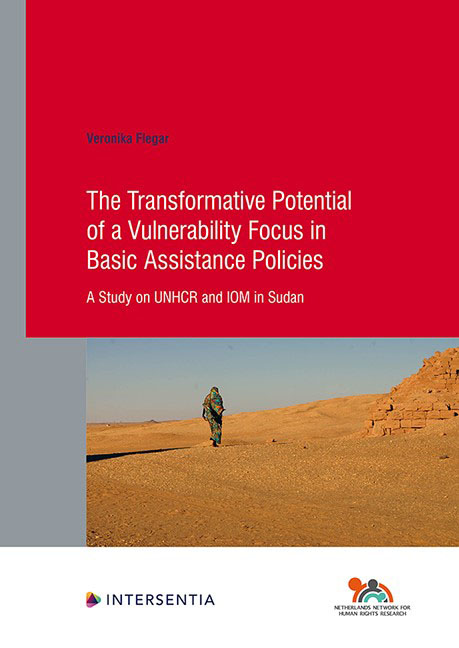 The Transformative Potential of a Vulnerability Focus in Basic Assistance Policies
The Transformative Potential of a Vulnerability Focus in Basic Assistance Policies Book contents
- Frontmatter
- Dedication
- Preface and Acknowledgements
- Contents
- List of Abbreviations
- List of Tables
- List of Figures
- Chapter 1 Introduction
- PART I NORMATIVE AND EMPIRICAL THEORY
- PART II BACKGROUND TO THE CASE STUDIES
- PART III CASE 1: ASSESSING AND ADDRESSING VULNERABILITY AT UNHCR KHARTOUM
- PART IV CASE 2: ASSESSING AND ADDRESSING VULNERABILITY AT IOM KHARTOUM
- PART V
- Bibliography
- Samenvatting
- Summary
- About the Author
- Human Rights Research Series
Chapter 10 - Background on IOM in Sudan
Published online by Cambridge University Press: 11 November 2021
- Frontmatter
- Dedication
- Preface and Acknowledgements
- Contents
- List of Abbreviations
- List of Tables
- List of Figures
- Chapter 1 Introduction
- PART I NORMATIVE AND EMPIRICAL THEORY
- PART II BACKGROUND TO THE CASE STUDIES
- PART III CASE 1: ASSESSING AND ADDRESSING VULNERABILITY AT UNHCR KHARTOUM
- PART IV CASE 2: ASSESSING AND ADDRESSING VULNERABILITY AT IOM KHARTOUM
- PART V
- Bibliography
- Samenvatting
- Summary
- About the Author
- Human Rights Research Series
Summary
This short introductory chapter provides background information on IOM in Sudan at the time of research. This seeks to facilitate the reader's understanding of the particularities of the specific case investigated in this study. The chapter outlines IOM's mission in Sudan (10.1), IOM's policy of Migrant Resource and Response Centres (MRRCs) on which this study focuses (10.2) and the policy process underlying the vulnerability assessments’ design and implementation at the MRRC in Khartoum (10.3).
IOM MISSION IN SUDAN
SIZE AND STRUCTURE OF THE MISSION
IOM counted 181 staffmembers in its 2017–2019 Strategic Plan but more detailed information on IOM's staffcomposition in its mission in Sudan was not publically available at the time of research. IOM had one head office in Khartoum (with the MRRC being housed in a separate building in a different part of the city) and six suboffices in South and West Kordofan, North Darfur, South Darfur and West Darfur. The Khartoum office was the main office while all other offices were field offices (and therefore much smaller in size). The present case study focuses exclusively on the main office in Khartoum. The IOM office in Khartoum was subdivided into three major thematic units: the Preparedness and Emergency Unit, the Transition and Reintegration Unit and the Migration Management and Development Unit. The MRRC was part of the last one of these three units.
KEY PRIORITIES AND BUDGET OF IOM IN SUDAN
According to IOM Sudan's Strategic Framework for 2017–2019, the central aim of IOM's activities in Sudan at the time of research was “to support the Government of Sudan and its people to address the challenges and opportunities before, during and after a migration crisis” and “to align its programmatic development and approaches with the principles and objectives of good migration governance”. IOM distinguished three pillars with regard to this overarching objective, namely: 1) the provision of effective humanitarian response, 2) early recovery and transition and 3) the promotion of national ownership preparedness and resilience.
IOM's actual expenditures were not publicly available at the time of this research. However, IOM estimated the budget for these three pillars for the three-year period to be US$ 133.925.000.
- Type
- Chapter
- Information
- The Transformative Potential of a Vulnerability Focus in Basic Assistance PoliciesA Study on UNHCR and IOM in Sudan, pp. 269 - 276Publisher: IntersentiaPrint publication year: 2020
